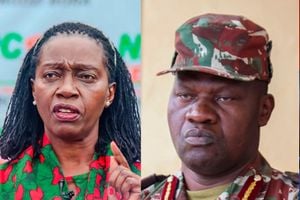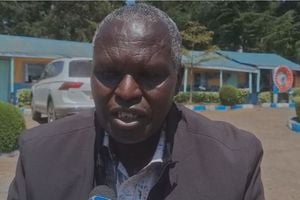Court orders State to pay Sh2m to police brutality victim

Nasa Supporters hold anti-poll demos across the streets of Kisumu on October 24, 2017.
What you need to know:
- But after considering all the submissions before her, Kisumu High Court Judge Justice Roselyne Aburili ruled that the evidence presented by Mr Onunga before the court and the doctor corroborated the petitioner's claim of violating his right.
- The judge also stated that while the police tried to clear the road, they claimed they did not use live bullets, but were firing blanks.
- She also stated that no substantial explanation regarding the shooting was provided by the respondents, other than the claim that the officers utilised blanks instead of live ammunition.
The State has been ordered to pay Sh2 million to a victim of police brutality during the opposition protests that rocked Kisumu in 2017.
Mr Bernard Onunga was awarded general damages after he was shot and his face disfigured by anti-riot police during violent demonstrations ahead of the repeat presidential election in 2017.
On October 26, 2017, the Supreme Court ordered a repeat presidential election after Jubilee’s Uhuru Kenyatta victory was overturned.
But despite a call for a repeat election, the then Opposition Party National Super Alliance leader, Raila Odinga, asked his supporters to boycott the polls leading to violence in many parts of Nyanza, Western, and Nairobi.
On this day, a confrontation between the police and protestors saw many killed and others injured.
One of those shot and left for dead was Mr Benard Onunga. He had left his home in Kapere Village, Chemilil Ward, Kisumu County, to go and charge his phone at the nearby trading Centre.
When he approached Ogen Primary School, he met a crowd fleeing from armed police officers.
He hid behind some of the buildings at the shopping center only to be shot by a police officer who left him for dead.
According to Mr Onunga, he neither provoked nor engaged with the police officer in any confrontation The actions of the rogue police officers traumatised him because he was unarmed yet he was callously left for dead as he bled profusely from his left ear and limbs.
He was later taken to Jaramogi Oginga Odinga Teaching and Referral Hospital where he was admitted for three days.
In a petition filed on April 13, 2023, he listed the Inspector General of the National Police Service and the Attorney General as first and second respondents.
He listed the Independent Policing Oversight Authority (IPOA) and the Kenya National Commission on Human Rights (KNCHR) as interested parties.
Dr Lucy Ombok, who testified, told the court that Mr Onunga had been shot by a police officer well known to him.
On examination, Dr Ombok stated that it was evident that the petitioner had a healed wound on the left jaw. She testified that the injury was five years old and was grievous.
However, in defence, Mr Joshua Nyasimi, a Superintendent of Police, said on the material date of the incident, officers from the prison department were assigned to escort public service vehicles trapped between Kopere and Awasi, when they found the road barricaded with rocks.
In the process of unblocking the road, they were accosted by a hostile mob and members of the public who threw stones at them.
He added that the said officers managed to turn back and leave the scene unhurt without using any live ammunition. In cross-examination, he reiterated that the officers never had live ammunition and only had blanks.
The defence also submitted that due to a lack of ballistic report proving the petitioner was shot by the police and a ‘fairly conflicting’ medical report, it could not be drawn that the police shot Mr Onunga.
But after considering all the submissions before her, Kisumu High Court Judge Justice Roselyne Aburili ruled that the evidence presented by Mr Onunga before the court and the doctor corroborated the petitioner's claim of violating his right.
The judge also stated that while the police tried to clear the road, they claimed they did not use live bullets, but were firing blanks.
She also stated that no substantial explanation regarding the shooting was provided by the respondents, other than the claim that the officers utilised blanks instead of live ammunition.
There was no evidence by way of an Occurrence Book entry or any other such document to show that the petitioner was suspected of terrorism or that he exchanged fire with the police officers or that he was part of the mob that allegedly attacked the police officers.
“No evidence was adduced by the respondent in support of this allegation. The police could have even presented a record of the armory detailing the guns and ammunition issued on that specific date so that the court could ascertain whether the same were blanks or not, but alas the respondents did not do so,” said Justice Aburili.
The judge found that the constitutional rights of the victims were violated.
The court considered the nature of the violation and the injury suffered by Mr Onunga before awarding him the damages.
Though he was alive, he lost his health and well-being, and being medically stabilized, also lost his job.
“In this case, considering the nature of the violation and the injury suffered which disfigured the petitioner’s face, I find that an award of Sh2,000,000 would be sufficient General damages for pain and suffering and constitutional rights violations,” said Justice Aburili.
The petitioner shall also have the costs of the petition to be assessed.





